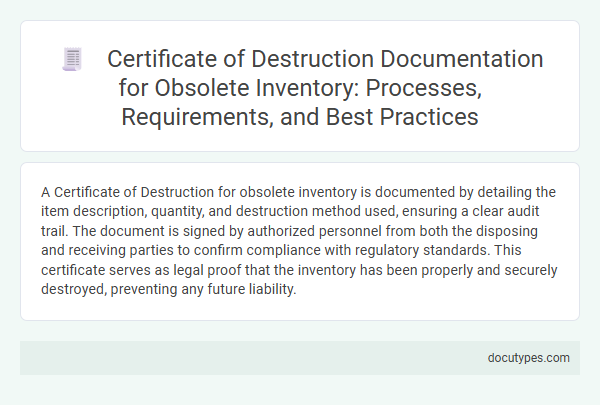A Certificate of Destruction for obsolete inventory is documented by detailing the item description, quantity, and destruction method used, ensuring a clear audit trail. The document is signed by authorized personnel from both the disposing and receiving parties to confirm compliance with regulatory standards. This certificate serves as legal proof that the inventory has been properly and securely destroyed, preventing any future liability.
Introduction to Certificate of Destruction for Obsolete Inventory
A Certificate of Destruction is a formal document verifying the proper disposal of obsolete inventory. It serves as proof that items have been destroyed following legal and environmental standards.
- Purpose - Confirms that obsolete inventory was destroyed securely to prevent reuse or resale.
- Content - Details include the type of inventory, quantity, destruction method, date, and responsible party.
- Use - Your business can use this certificate for regulatory compliance and audit trails.
Importance of Proper Destruction Documentation
How is a Certificate of Destruction documented for obsolete inventory? A Certificate of Destruction is recorded through detailed documentation that includes the date, method of destruction, and a description of the inventory destroyed. Proper destruction documentation ensures legal compliance and provides a verifiable audit trail for inventory control.
Legal and Regulatory Requirements for Certificates of Destruction
A Certificate of Destruction serves as crucial legal documentation confirming the proper disposal of obsolete inventory. It must comply with specific regulatory requirements to ensure validity and traceability.
- Compliance with Environmental Laws - Certificates must adhere to regulations such as RCRA or local environmental protection standards governing hazardous and non-hazardous waste disposal.
- Inclusion of Detailed Inventory Information - The document should specify item descriptions, quantities, and destruction dates to maintain accurate records for audits.
- Verification by Authorized Personnel - Signature and contact information of certified professionals responsible for destruction are mandatory to validate the certificate.
Key Components of a Certificate of Destruction Document
A Certificate of Destruction for obsolete inventory serves as official proof that items have been securely and permanently disposed of. This document is essential for compliance, risk management, and auditing purposes.
Key components of a Certificate of Destruction include a detailed description of the inventory destroyed, the date and method of destruction, and the signatures of authorized personnel involved in the process. It also contains the company information and a unique reference or certificate number for traceability. These elements ensure transparency and accountability throughout the disposal process.
Step-by-Step Process for Issuing Destruction Certificates
| Step | Process Description |
|---|---|
| 1. Identification of Obsolete Inventory | Catalog all obsolete or end-of-life inventory items requiring destruction. Use inventory management systems to verify and list the items accurately. |
| 2. Authorization for Destruction | Obtain formal approval from authorized personnel or management. Documentation should include details like item description, quantity, and reasons for destruction. |
| 3. Selection of Destruction Method | Determine the appropriate destruction technique based on the type of inventory, such as shredding, incineration, or degaussing for electronic goods. |
| 4. Execution of Destruction | Carry out the destruction process under supervision to ensure compliance with environmental and safety regulations. |
| 5. Documentation of Destruction | Record the destruction details, including date, method used, and responsible personnel. This forms the basis of the Certificate of Destruction. |
| 6. Issuance of Certificate of Destruction | Generate a formal document certifying that the obsolete inventory was destroyed properly. This certificate includes item details, destruction method, date, and signatures of authorized parties. |
| 7. Distribution and Storage | Provide copies of the Certificate of Destruction to relevant stakeholders. Store the original certificate securely for compliance and audit purposes. |
| 8. Audit and Verification | Conduct periodic reviews to verify destruction records and confirm certificate authenticity as part of inventory control and compliance management. |
Roles and Responsibilities in the Destruction Documentation Process
The Certificate of Destruction for obsolete inventory must be meticulously documented to ensure compliance with regulatory standards. This document provides proof that materials have been securely and properly destroyed.
Warehouse managers are responsible for initiating the destruction process and verifying the details before destruction begins. The logistics team coordinates the physical destruction and compiles necessary records.
Quality assurance specialists review and approve the destruction process to confirm that all inventory has been rendered unusable. Compliance officers then audit the documentation to validate adherence to legal and company policies.
Your role includes maintaining accurate records and ensuring that all involved parties fulfill their responsibilities. Proper documentation protects your company from liability and supports sustainability efforts.
Recordkeeping and Audit Trail Considerations
A Certificate of Destruction for obsolete inventory must be thoroughly documented to ensure compliance and traceability. Accurate recordkeeping involves detailing the item descriptions, quantities destroyed, destruction date, and the responsible parties' signatures. Maintaining an audit trail with digital or physical copies supports regulatory verification and internal inventory controls.
Common Challenges and How to Address Them
Documenting a Certificate of Destruction for obsolete inventory involves accurately recording the disposal process to ensure compliance with regulatory standards. Common challenges include incomplete information and lack of verification from third-party disposal services.
To address these issues, implement a standardized documentation procedure that captures all relevant details such as item descriptions, quantities, and destruction dates. You should also require certified disposal companies to provide signed and verifiable certificates that confirm the inventory has been properly destroyed.
Best Practices for Secure and Compliant Documentation
A Certificate of Destruction for obsolete inventory is documented through a detailed record that includes the date, method of destruction, and responsible parties involved. Best practices for secure and compliant documentation involve using tamper-proof digital systems to log and verify the destruction process. Maintaining these records ensures regulatory compliance, audit readiness, and protects against liability risks.
How Is a Certificate of Destruction Documented for Obsolete Inventory? Infographic

